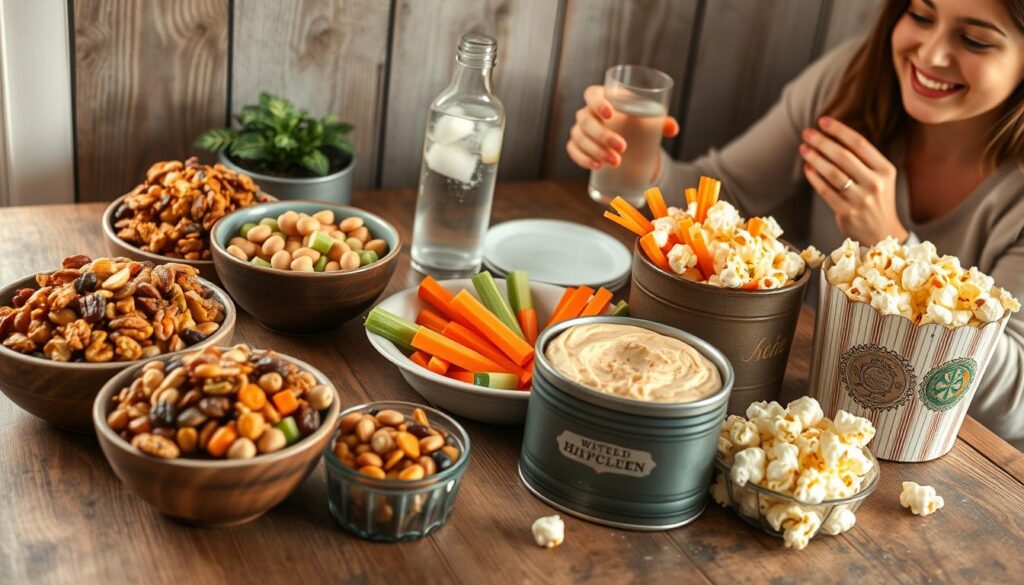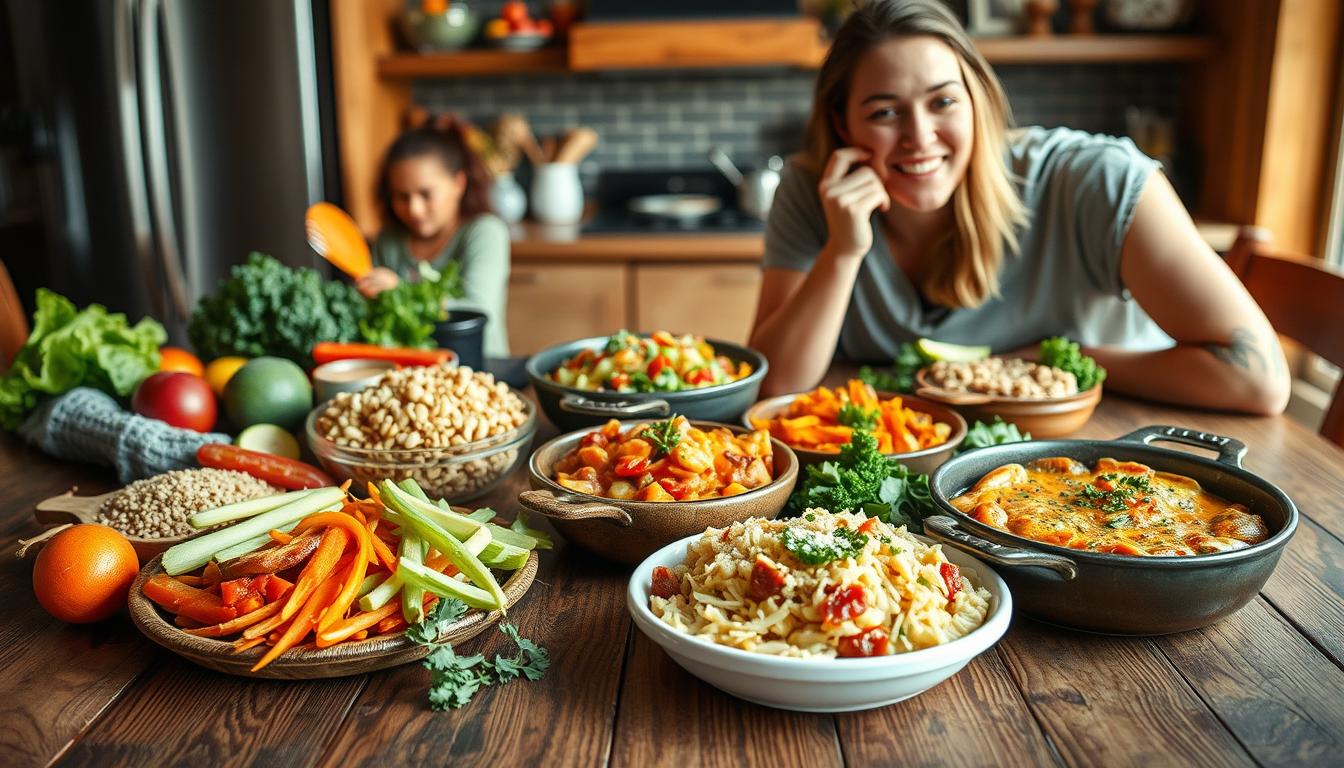Eating on a budget doesn’t mean you have to give up taste or variety. You can make delicious and affordable meals with a bit of planning and creativity.
Learn how to make mouth-watering dishes without spending too much. You’ll discover how to plan meals and use cooking techniques to save money. With these low-cost meal ideas, you can enjoy your favorite foods without breaking the bank.
Key Takeaways
- Plan your meals in advance to save money
- Use affordable ingredients to create delicious dishes
- Master simple cooking techniques to enhance flavor
- Explore budget-friendly cuisines from around the world
- Make the most of leftovers to reduce food waste
Understanding Budget-Friendly Meals
Learning to cook on a budget means making smart choices in the kitchen. It saves money and lets you eat healthy, tasty meals without spending a lot. To cook on a budget, you first need to know what it’s all about.
What Are Budget-Friendly Meals?
Budget-friendly meals use cost-effective ingredients but are still tasty and healthy. They are made to be inexpensive and filling. This makes them great for saving money, whether you’re alone or with a family.
Some key traits of budget-friendly meals include:
- Using affordable ingredients
- Reducing food waste
- Keeping recipes simple
- Being balanced in nutrition
Importance of Meal Planning
Meal planning is key to frugal meal planning. It helps avoid food waste and saves money on takeout or dining out. Planning meals ahead also lets you:
- Make a shopping list to avoid buying too much
- Prepare meals in large batches, saving time and money
- Try new recipes, making mealtime exciting
Benefits of Cooking at Home
Cooking at home is a big part of budget-conscious cooking. It has many advantages, such as:
- Being able to choose healthier ingredients
- Saving money compared to eating out or getting takeout
- Being able to cook in bulk for future meals
By learning about budget-friendly meals, you can make many tasty and healthy dishes without spending too much. Whether you’re busy or have a family, cooking on a budget is helpful for everyone.
Essential Ingredients for Budget Meals
Starting with the right ingredients is key to making budget meals. A well-stocked pantry lets you cook tasty meals fast and cheap. It’s all about being ready and knowing what to keep.
Staple Pantry Items
A good pantry is the base for economical recipes. It should have rice, pasta, canned beans, and tomatoes. These items are cheap and can be used in many ways. For example, rice can be a side dish, a main dish, or even rice cakes.
As Julia Child said, “The only time to eat diet food is while you’re waiting for the steak to cook.” This shows the value of a solid pantry for tasty meals. Having staples means you’re always set to cook a meal that’s both filling and tasty.
Seasonal Produce for Savings
Using seasonal produce helps save money. Produce in season is cheaper because it’s more common and travels less. You can find it at farmer’s markets or in stores. Eating seasonal fruits and veggies saves money and keeps you healthy.
Affordable Proteins to Consider
Protein is key in meals, but it doesn’t have to cost a lot. Beans, lentils, and eggs are cheap and full of nutrients. Canned tuna and chicken are also affordable and versatile.
To use these proteins well, try new recipes. Make lentil soup, a bean salad, or an omelette with veggies. Being open to new recipes helps stay within your budget.
Easy Breakfast Ideas on a Budget
You don’t have to spend a lot to have a tasty and healthy breakfast. A little creativity can help you make a nutritious meal that’s easy on your wallet. Breakfast gives you the energy to start your day right.
Overnight Oats Variations
Overnight oats are a great breakfast choice. You can mix rolled oats with milk and add fruits, nuts, or seeds. Then, refrigerate it overnight. In the morning, you’ll have a yummy, filling breakfast.
- Peanut Butter Banana Oats: Mix oats with milk, mashed banana, and peanut butter for a creamy treat.
- Fruit and Nut Oats: Combine oats with milk, your favorite fruits (such as berries or sliced banana), and a handful of nuts.
Vegetable Omelettes
Omelettes are a flexible breakfast choice. Whisk eggs with salt and pepper, then add diced veggies. Cook into an omelette. Serve with whole-grain toast or a side salad.
Some popular vegetable combinations include:
- Spinach and Feta: Add chopped spinach and crumbled feta cheese for a Greek-inspired omelette.
- Mushroom and Onion: Sautéed mushrooms and onions make for a hearty and savory omelette.
Budget-Friendly Smoothies
Smoothies are a quick and easy breakfast. Blend your favorite fruits, yogurt, and milk for a tasty and healthy smoothie.
| Smoothie | Ingredients | Cost |
|---|---|---|
| Banana Berry | Banana, mixed berries, yogurt, milk | $1.50 |
| Mango Peach | Mango, peaches, yogurt, milk | $2.00 |

Wholesome Lunch Recipes
Eating a nutritious lunch doesn’t have to cost a lot. With a little planning, you can make budget-conscious cooking that tastes great and saves money.
Simple Salad Combinations
Salads are a smart choice for a healthy, affordable lunch. Mix and match different ingredients to make inexpensive dishes. Start with greens, add beans, eggs, or canned tuna, and top with seasonal veggies.
Try a spinach salad with cherry tomatoes, cucumber, and a simple vinaigrette. It’s filling and won’t empty your wallet. As Alice Waters said, “The best food is made with love and care, and that’s what you get when you cook for yourself.”
“The best food is the food that is made with love and care, and that is what you get when you cook for yourself.” – Alice Waters
Bulk Cooking for Lunch
Bulk cooking is key to frugal meal planning. It saves time and money. Cook grains, beans, and roasted veggies in big batches, then portion them for meals.
- Cook a big batch of quinoa or brown rice at the start of the week.
- Roast veggies like broccoli, carrots, and sweet potatoes.
- Use these to make different lunches all week.
Budget-Friendly Wraps and Sandwiches
Wraps and sandwiches are inexpensive lunch options. You can fill them with turkey, ham, hummus, or falafel.
Use leftovers for your fillings. A sandwich with leftover roast chicken, lettuce, and tomato on whole grain bread is tasty and cheap.
By using these ideas, you can have healthy lunches without spending a lot. Happy cooking!
Affordable Dinner Options
Learn how to make dinner cheap and tasty with our budget-friendly meal ideas. Dinner is the main meal of the day. There are many ways to make it affordable without losing taste or nutrition.
One-Pot Meals That Save Time
One-pot meals are a game-changer for busy weeknights. They are quick and easy to clean up. Plus, they make delicious, comforting meals. Try making a hearty stew or a simple pasta dish in one pot.
Slow Cooker Recipes for Cost Efficiency
Slow cookers are great for cooking all day. They make tough meat tender and tasty. They’re perfect for cost-effective meals like chili, stews, or pulled pork. Just add your ingredients in the morning, and you’ll have a meal ready when you get home.
Pasta Dishes on a Budget
Pasta is a staple in many homes and is very budget-friendly. You can make many dishes, from simple spaghetti with tomato sauce to more complex ones. Pasta dishes are also good for using up leftovers, making them even cheaper.
By adding these dinner ideas to your meal plan, you can enjoy economical recipes that are both tasty and satisfying. Whether you’re cooking for one or a family, these cheap eats will help you stay within your budget. You won’t have to give up flavor or quality.
Creative Snacks Without Breaking the Bank
With a little creativity, you can enjoy tasty snacks without overspending. Snacking is a big part of our daily lives. You can make snacks that are yummy and won’t cost a lot.
Let’s look at some fun snack ideas that are easy on your wallet. Here are a few to start with:
Homemade Granola Bars
Making your own granola bars is a smart way to save money. You can use cheap ingredients like oats, nuts, and dried fruits. This way, you get healthier snacks that are also cheaper than store-bought ones.
- Use rolled oats as the base for your granola bars.
- Add nuts like almonds or walnuts for crunch.
- Incorporate dried fruits like cranberries or raisins for natural sweetness.

Veggies and Dips
Vegetables with a tasty dip make a great snack. Try carrot sticks with hummus or cucumber slices with tzatziki. You can buy veggies in bulk and make your dips at home with cheap ingredients.
Tips for making veggie snacks:
- Buy seasonal vegetables to save money.
- Prepare dips like hummus or guacamole at home.
- Portion your snacks to avoid overeating.
Fruit and Nut Mixes
A mix of dried fruits and nuts is a healthy and filling snack. You can pick your favorite ingredients. Making your own trail mix can save you money compared to buying pre-made mixes.
Try combining nuts like almonds or cashews with dried fruits like apricots or mangoes for a delicious and healthy snack.
By adding these snack ideas to your daily routine, you can enjoy healthy and tasty snacks without spending a lot. The secret to affordable snacking is being creative and planning ahead.
Leftover Makeovers
Leftover makeovers are great for saving money. They turn last night’s dinner into tomorrow’s lunch or a new meal. This way, you waste less food and spend less on groceries. Plus, it makes your meals more interesting.
Repurposing Leftovers
Seeing the potential in leftovers is key. Leftover roasted veggies can make a tasty soup or add to a salad. You can also make croutons or breadcrumbs from leftover bread.
Start by looking at what leftovers you have. Think about how you can change them. Maybe turn last night’s chicken into chicken salad or tacos.
Creative Uses for Casserole Dishes
Casseroles are perfect for using leftovers. They mix different ingredients into one dish. You can change the topping or add new ingredients to make it new again.
Try using leftover casserole as a filling for stuffed veggies or on baked potatoes. There are so many ways to be creative with leftovers.
Transforming Proteins into New Meals
Proteins like chicken, beef, and fish can be used in many ways. Shredded or diced meat is great in sandwiches, wraps, or on salads. You can also make stir-fries, stews, or curries with leftover proteins.
For example, leftover grilled chicken can become chicken Caesar salad or quesadillas. Being open to new ideas keeps your meals exciting and varied.
Tips for Grocery Shopping on a Budget
Smart grocery shopping is key to economical recipes. Here are some tips to help you shop on a budget. Shopping wisely is the first step to cost-effective dining. With a few simple strategies, you can save money without losing meal quality.
Making a Shopping List
Plan your meals for the week before you go shopping. This helps you make a focused shopping list. You’ll avoid impulse buys and save money by sticking to your list.
Check what you already have at home before you shop. This prevents buying things you already have. Use apps or digital tools to keep track of your list and find sales.
Utilizing Coupons and Discounts
Coupons and discounts can cut your grocery bill. Look for digital coupons on store websites or apps. Also, check local newspapers or flyers for paper coupons. Many stores offer loyalty programs for extra savings.
Use coupons with items on sale to save more. Some stores have double coupon days or special deals for loyalty members. Keep up with these to buy non-perishable items at the best prices.
Buying in Bulk Smartly
Buying in bulk can save money on non-perishable items. But, check the cost per unit to make sure it’s a good deal. Also, have enough space for bulk items to avoid waste.
Buying perishable items in bulk can work too. Freeze them before they expire. For example, buying bulk chicken breasts and freezing them is cost-effective and convenient.
By using these strategies, you’ll get better at grocery shopping on a budget. Whether you’re making cheap eats or fancy meals, smart shopping is the secret to saving money.
Meal Prep for Cost-Effective Eating
Preparing meals ahead of time saves time and money. It’s a great way to enjoy meals without daily cooking stress. Just spend a few hours each week on meal prep.
Planning Your Weekly Meals
Plan meals with affordable recipes and low-cost ideas. Check what you have at home and what’s on sale. This cuts down on waste and saves money.
Storage Solutions for Bulk Meals
Good storage containers are key for meal prep. Choose ones that are airtight, microwave-safe, and stackable. They keep meals fresh and organized.
Benefits of Prepping Ahead
Meal prep saves time, reduces waste, and sticks to your budget. It lets you enjoy healthy meals without stress. This habit keeps your diet balanced and expenses low.
FAQ
What are some budget-friendly meal ideas?
You can make tasty and cheap meals like one-pot pasta, slow cooker dishes, and veggie stir-fries. Try meal prepping and using leftovers to save money and reduce waste.
How can I save money on groceries?
To cut down on grocery bills, make a shopping list and use coupons. Buy in bulk and shop for seasonal produce. Visit local farmers’ markets too.
What are some affordable protein sources?
Affordable proteins include beans, lentils, eggs, and canned tuna. Buying in bulk and freezing chicken and ground beef can also help.
How can I make meal prep cost-effective?
For affordable meal prep, plan meals around sales, buy in bulk, and use leftovers. Cooking meals that can be reheated or repurposed is smart.
What are some budget-friendly breakfast ideas?
Budget-friendly breakfasts include overnight oats, scrambled eggs, and avocado toast. Meal prep breakfast burritos or muffins is a good idea too.
How can I reduce food waste?
Reduce waste by planning meals, using leftovers, and composting. Freezing near-expired food is another way to help.
What are some inexpensive dishes for a large family?
For a big family, try pasta with marinara, tacos, and stir-fries. Meal prepping and using leftovers can stretch your budget.
How can I make cooking on a budget more efficient?
To cook on a budget better, plan meals, use one-pot recipes, and cook in bulk. Slow cookers and instant pots save time.
What are some economical recipes for dinner?
Economical dinners include bean chili, lentil soup, and roasted chicken with veggies. Meal prepping and using leftovers are great ideas.
How can I make healthy meals on a budget?
For budget-friendly healthy meals, plan meals, use seasonal produce, and cook at home. Meal prepping and using leftovers reduce waste.




